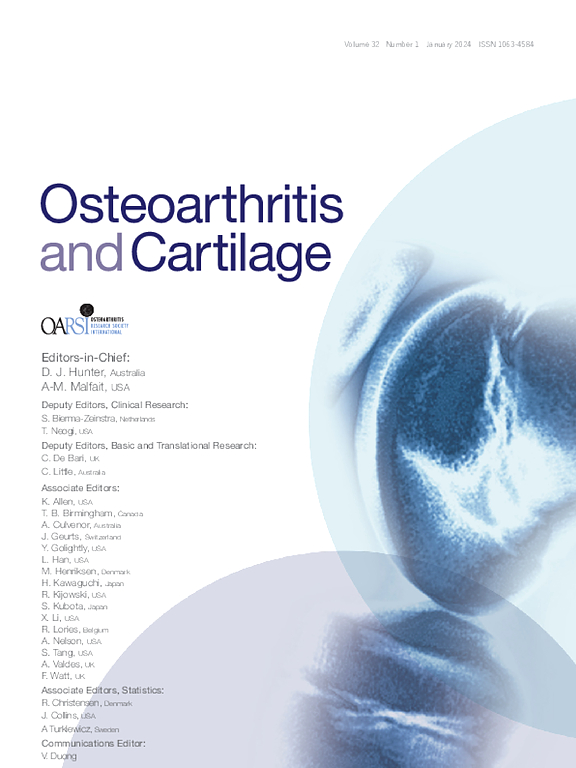Frequent use of prescription NSAIDs among people with knee or hip osteoarthritis despite contraindications to or precautions with NSAIDs
IF 7.2
2区 医学
Q1 ORTHOPEDICS
引用次数: 0
Abstract
Objective
To describe the use of non-steroidal anti-inflammatory drugs (NSAID), opioids, and physiotherapy (PT) among persons with newly diagnosed knee or hip osteoarthritis (OA) with and without NSAID contraindications or precautions.
Design
We used population-based register data to identify adults aged ≥35 as of January 1, 2014, residing in Skåne region (Sweden) between 2004 and 2013, without a previous knee or hip OA diagnosis. Among this cohort, we identified people with incident knee or hip OA diagnosis between 2014 and 2018 and the presence of contraindications to or precautions for oral NSAIDs at the time of OA diagnosis. We estimated the risk of 1) regular oral NSAID use, 2) regular opioid use, and 3) PT during the first year after diagnosis among those with vs. without contraindications or precautions using confounder-adjusted logistic regression with standardization.
Results
We identified 35,173 persons with newly diagnosed OA, of whom 3257 and 8351 had ≥1 contraindication to oral NSAIDs and ≥1 precaution, respectively. Overall, 27% of individuals used oral NSAIDs (with or without opioids or PT), 10% used opioids, and 57% attended PT. Among patients with contraindications, 21% used oral NSAIDs compared to 31% without (absolute adjusted difference −0.06 (95% CIs: −0.08, −0.05)), 53% vs 59% used PT (adjusted difference −0.03 (−0.05, −0.01)), while 14% vs. 8% had prescribed dispensed opioids (adjusted difference 0.02 (0.01, 0.03)). Similar results were observed for those with precautions.
Conclusions
We highlight the need for safer treatment options. People with OA and contraindications/precautions to NSAIDs have a higher risk of opioid use, slightly lower risk of PT use, and continue to be prescribed NSAIDs.
尽管有非甾体抗炎药禁忌症或注意事项,膝关节或髋关节骨性关节炎患者仍频繁使用处方非甾体抗炎药。
目的描述新诊断为膝关节或髋关节骨性关节炎(OA)的患者使用非甾体类抗炎药(NSAID)、阿片类药物和物理治疗(PT)的情况,包括有无NSAID禁忌症或注意事项:我们利用基于人口的登记数据,对 2004-2013 年间居住在斯科纳地区(瑞典)、截至 2014 年 1 月 1 日年龄≥35 岁、既往未确诊过膝关节或髋关节 OA 的成年人进行了识别。在这一队列中,我们确定了在 2014-2018 年间诊断出膝关节或髋关节 OA 的人群,以及在诊断出 OA 时是否存在口服非甾体抗炎药的禁忌症或预防措施的人群。我们估计了以下情况的风险使用混杂因素调整的标准化逻辑回归,我们估算了:1)定期使用口服非甾体抗炎药;2)定期使用阿片类药物;3)在诊断后第一年内,有禁忌症或预防措施与无禁忌症或预防措施者的 PT 风险:我们发现了35173名新确诊的OA患者,其中3257人和8351人分别有≥1个口服非甾体抗炎药禁忌症和≥1个预防措施。总体而言,27%的人使用了口服非甾体抗炎药(使用或不使用阿片类药物或PT),10%的人使用了阿片类药物,57%的人参加了PT。在有禁忌症的患者中,21%的人使用口服非甾体抗炎药,而 31% 的人不使用(调整后绝对差异为 -0.06 (95% CIs: -0.08, -0.05));53% 的人使用 PT,而 59% 的人不使用 PT(调整后差异为 -0.03 (-0.05, -0.01));14% 的人使用处方配发的阿片类药物,而 8% 的人不使用处方配发的阿片类药物(调整后差异为 0.02 (0.01, 0.03))。在有预防措施的人群中也观察到了类似的结果:我们强调需要更安全的治疗方案。患有 OA 且有非甾体抗炎药禁忌症/注意事项的患者使用阿片类药物的风险较高,使用 PT 的风险略低,且继续被开具非甾体抗炎药处方:研究中使用的所有数据均可向瑞典国家有关部门索取。
本文章由计算机程序翻译,如有差异,请以英文原文为准。
求助全文
约1分钟内获得全文
求助全文
来源期刊

Osteoarthritis and Cartilage
医学-风湿病学
CiteScore
11.70
自引率
7.10%
发文量
802
审稿时长
52 days
期刊介绍:
Osteoarthritis and Cartilage is the official journal of the Osteoarthritis Research Society International.
It is an international, multidisciplinary journal that disseminates information for the many kinds of specialists and practitioners concerned with osteoarthritis.
 求助内容:
求助内容: 应助结果提醒方式:
应助结果提醒方式:


